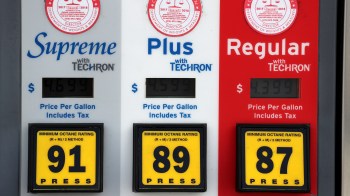‘Go’ Gulf zones two years after Katrina
TEXT OF STORY
Tess Vigeland: President Bush flies to New Orleans today. Tomorrow, he’ll examine recovery efforts on the second anniversary of Hurricane Katrina’s landfall.
The president may have to go further inland for any real signs of economic revival. Several New Orleans neighborhoods are still in utter ruin. More than $100 billion in federal aid was supposed to help rebuilding efforts in the Gulf Coast region, but more than half of it is still tied up in bureaucracy.
And what is being spent isn’t finding its way to the hardest-hit areas. Marketplace’s Sam Eaton reports.
Sam Eaton: The giant steel beams of Price LeBlanc’s new Toyota dealership reveal an emerging structure that rivals the size of many sports stadiums. Hundreds of construction workers swarm the site, assembling what will soon become a $20-million vehicle showroom — all funded through federal tax breaks.
After hurricanes Katrina and Rita, Congress approved billions of dollars in tax-free bonds to stimulate rebuilding along the Gulf Coast. It’s called the Gulf Opportunity Zone — or GO Zone — and includes dozens of counties in Louisiana, Mississippi and Alabama. But as new developments like Price LeBlanc’s Toyota dealership cash in on federal aida€¦ a trend is taking shape. The dealership is in Baton Rouge, nearly a hundred miles inland from Katrina’s wrath.
Ivan Miestchovich: I think it’s anything but a best-case scenario, that’s for sure.
Ivan Miestchovich heads the Center for Economic Development at the University of New Orleans.
Miestchovich: Where the money has generally tended to flow is to areas that were impacted by the hurricane but did not necessarily sustain the type of devastating impact that the city of New Orleans did.
In Louisiana, over half of the GO Zone money has already been allocated. But only a tenth of a percent of the awarded projects are in New Orleans. City council president Arnie Fielkow says that’s not what Congress intended.
Arnie Fielkow: It’s supposed to impact the areas that we’re most affected by the hurricanes and by in this case what was the failure of the federal government to have a safe flood protection system.
The City Council recently passed a resolution asking the state Bond Commissiona€¦ which dishes out the casha€¦ to reserve what remains for Louisiana’s most damaged Parishes. But whether that would help funnel more money into New Orleans is open for debate. Annie Clark with the nonprofit group Policy Link says projects in New Orleans face a unique set challenges.
Annie Clark: Part of it is just the permitting process here. City government is really overburdened. They only have a third of their staff and so getting through that process can be very difficult. And then again insurance costs has gone through the roof. You know people are saying up to five times as to what it was before the storm.
And then there’s the city’s image problem. Crime is on the rise. A longtime city councilman recently pleaded guilty to taking bribes. And one of the few Go Zone projects in New Orleans to receive final approval is now considered dead after the firm came under federal investigation for tax abuse.
All of this ads up to what the state Bond Commission says is the main reason New Orleans isn’t getting its share of the money: no one’s asking for it. Economist Ivan Miestchovich says all the tax free bonds in the world aren’t going to change that.
Miestchovich: Money is money and its going to flow to its lowest common denominator and the lowest common denominator is what’s the least risk with the highest return.
For most developers that means building on higher ground. Several parishes outside New Orleans have recently become some of the fastest growing counties in the nation. In Baton Rouge where the Toyota dealership is going up, the economy just had its two best years on record. The GO Zone money has helped. But Stephen Moret with the Baton Rouge Area Chamber of Commerce says the shift was already underway.
Stephen Moret: If you look back 20, 40, 50 years ago, New Orleans from a population and jobs perspective has been in a continual decline and the Baton Rouge area has been growing during that time. And that process essentially just got accelerated dramatically by Katrina.
Moret says the Big Easy still has a future in the region’s economy. It just won’t be the economic engine. In New Orleans, I’m Sam Eaton for Marketplace.
There’s a lot happening in the world. Through it all, Marketplace is here for you.
You rely on Marketplace to break down the world’s events and tell you how it affects you in a fact-based, approachable way. We rely on your financial support to keep making that possible.
Your donation today powers the independent journalism that you rely on. For just $5/month, you can help sustain Marketplace so we can keep reporting on the things that matter to you.


















